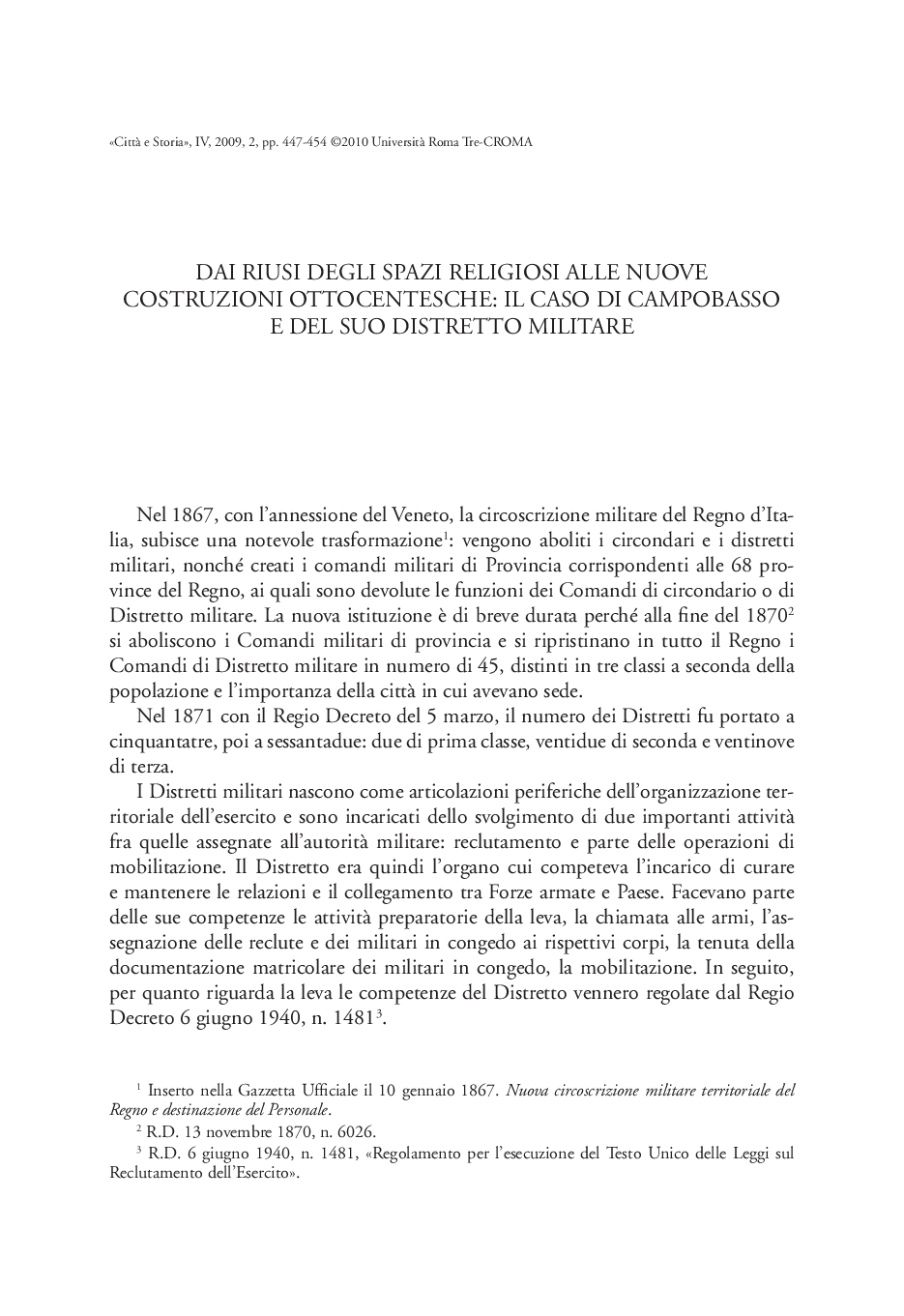Indice degli autori
CITTÀ & STORIA » 2009/2 » Spazi e cultura militare nella città dell'Ottocento
ISSN 1828-6364
Giuliano Antonietta
Dai riusi degli spazi religiosi alle nuove costruzioni ottocentesche: il caso di Campobasso e del suo Distretto militare
pp.447-454, DOI 10.17426/62651
Articoli
Abstract: The Military Districts rise as peripheral articulations of the army’s territorial organization and are responsible for carrying out two major activities amongst those assigned to the military authority: the recruitment and part of the mobilization operations. The District was, therefore, the organ in charge to assist and maintain the relations and ties between the armed forces and the Country. Part of its responsibilities was to prepare for national service, the call to arms, to assign the recruits and discharged soldiers to their respective bodies, to keep the discharged soldiers registration documents and for mobilization. Later on, regarding the national service, the District’s responsibilities were sorted out by the Royal Decree of the 6th of June 1940, n. 1481. In this legislative context we have the birth of the Military District of Campobasso, formerly the headquarters of the Provincial Military Command according to the Royal Decree in 1867. This institution goes perfectly with the expansion of Campobasso , which started back in 1806, when it was still part of the Kingdom of Naples, in conjunction with its proclamation as the capital city, and it saw the town grow and evolve also from the urban point of view, like other provincial capitals in Italy. In particular, the small city of Campobasso has the advantage of being rebuilt almost from scratch after the earthquake of 26th July 1805 that destroys almost completely the town. The new Campobasso starts to rise at the beginning of the nineteenth century; eager to build outside the walls, the people received the permission from the murattinian government with the Royal Decree of 25th August 1814, which authorized «the construction of a village outside the ancient walls towards the road that leads to Naples according to the project by the architect Berardino Musenga».
In this context we have the construction of the Military District of Campobasso’s headquarters, that was established in 1871 and for the first ten years was housed in temporary places: first in the convent of «Santa Maria delle Grazie» and then in the convent of «Annunziata». In 1874 the urge begins to find a more suitable location that would allow the quartering of the Garrison troops, of a regiment and the evacuation of the Holy Trinity church used for the troop’s accommodation.
The whole building occupied the area with a courtyard surrounded by walls; by the barracks were also several stalls for the mules, useful for the transport of the wagons and ammunition. When the district became the Completion Officers of the IX Corps of the Army Recruitment center more stables were built in the village Vazzieri upon directives of Civil Engineers and a mount centre with an area for foul breeding in Castle Avenue.
A series of documents testify the damage to the building due to the bombing and occupation by the German troops, that in 1943 set fire to the district during their retreat. The high costs of restructuring lead to a certain point, the decision to prepare the draft of a new Military District.
The question of the construction of the new Military District continues leading to the settlement of another project which means the construction of two buildings for the Command building, the District offices and the Clubs for officers and non-commissioned officers; a building for the aptitude selection and a building for the barracks. The high cost of the realization of the new structure leads to taking into account the old barracks. The recent history of the District sees a downgrading; on 30th June 1996 it was abolished and reset in regional military Command «Molise»(CMR Molise) with garrison functions and the promotion of the armed forces in order to attract interest in the voluntary service, though without any garrison authority in its own employment. The responsibilities of the Military District of Campobasso are taken up by the main Military District of Caserta.

Referenze
- download: n.d.
- Url: http://archivio.centroricercheroma.it/?contenuto=indice-degli-autori&idarticolo=905
- DOI: 10.17426/62651
- citazione: A. Giuliano, Dai riusi degli spazi religiosi alle nuove costruzioni ottocentesche: il caso di Campobasso e del suo Distretto militare, "Città & Storia", IV/2, pp.447-454, DOI: 10.17426/62651

